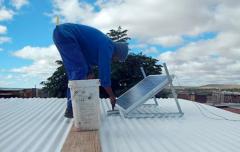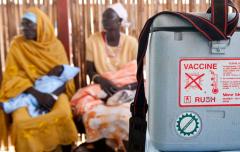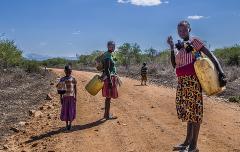Keep cool and carry on: how the Montreal Protocol is making cooling sustainable
This blog is the fourth of a four-part blog series focused on growing cooling needs for populations worldwide and opportunities for providing sustainable cooling solutions. The blogs are running in advance of a major report, “Chilling Prospects: Providing sustainable cooling for all,” coming out on Monday July 16. The report is authored by Sustainable Energy for All.
There are few greater pleasures in life than stepping inside on a baking hot day to feel that first chilly blast of air-conditioning on your sweaty neck or to pluck an ice-cold bottle from the fridge and soothe your parched throat.
The technology that makes this sweet relief possible brings many other benefits to those of us lucky enough to have access to it. Cooling makes robust food chains and waste prevention possible. It keeps medicines, vaccines and organs for transplants viable for long periods. It can even be a matter of survival in face of the growing heatwaves sweeping the globe.
Unfortunately, we have been paying a price for these benefits: the hole in the ozone layer that threatened human and planetary health, and a sizeable contribution to climate change.
It needn’t be this way, however, as the Montreal Protocol on Substances that Deplete the Ozone Layer has shown in the 31 years of its existence.
In the 1980s, after scientists proved that chlorofluorocarbons (CFCs) and other substances used in refrigeration and air conditioning were damaging the ozone layer and letting dangerous ultraviolet radiation flood through, we did something about it.
Under the Montreal Protocol, nations slashed the use of these substances. The ozone layer is now healing and will return to 1980 levels by mid-century, with many associated benefits – including an estimated two million cases of skin cancer avoided by 2030.
The challenge now is to keep protecting the ozone layer while increasing efforts to cut greenhouse gas emissions from the cooling industry.
Since many ozone-depleting substances also warm our planet, the Montreal Protocol mitigated an estimated 135 billion tonnes of CO2 equivalent emissions between 1990 and 2010. The Kigali Amendment to the Protocol is looking to take this climate contribution to the next level.
Part of the climate change threat comes from hydrofluorocarbons (HFCs), which replaced CFCs. While ozone-friendly, HFCs are powerful climate warming gases. Nations that ratify the Kigali Amendment, which enters into force on January 1, 2019, are committing to cutting the production and consumption of HFCs by more than 80 per cent over the next 30 years and replacing them with planet-friendly alternatives.
Their actions can potentially avoid up to 0.5°C of global warming by the end of the century, while continuing to protect the ozone layer. This will contribute to the Paris Climate Agreement, which targets limiting global warming this century to under 2°C compared to pre-industrial levels, with a more-ambitious 1.5°C as an aspirational target.
But HFCs aren’t the only problem. Cooling needs power. If this power comes from fossil-fuel sources, it contributes to climate change, which in turn increases global temperatures and the need for cooling. Energy efficiency can dampen this negative feedback loop, with opportunities for improvements abundant as the industry adjusts its technology to replace HFCs.
The benefits of action under the Montreal Protocol also reach across the whole sustainable development agenda.
By protecting the ozone layer, we have greatly reduced the damage UV-B radiation causes to plant species and ecosystems. This has contributed an estimated $460 billion in global benefits between 1987 and 2060 due to avoided damages to agriculture, fisheries and materials such as wood.
The Kigali Amendment, and the Protocol itself, can keep up this great work with commitment from all Parties. Business, which has supported the Kigali amendment and sees the opportunities in phasing out HFCs, will also need to continue to display leadership as implementation proceeds.
The Cooling for All Global Panel, of which I am part, will also play a key role. This year, the panel – made up of leaders from business, philanthropy, policy and academia – will issue recommendations to create a pathway for the poorest countries and their citizens to access sustainable cooling solutions.
The simple fact is that we need cooling systems. But we also need to make sure that the price we pay is not too high. This is why on September 16, 2018, World Ozone Day, we are urging everyone to Keep Cool and Carry On by celebrating the work so far, continuing to protect the ozone layer and accelerating action to take an even-bigger bite out of climate change.
Yes, global issues like climate change can seem overwhelming. But the Montreal Protocol, by bringing the world together to heal the ozone layer, has shown that there is no challenge we cannot face if we work together.





